Karski Tomasz1*, Karski Jacek2, Karska Klaudia2, Pyrc Jarosław3
1- Vincent Pol University in Lublin, Poland
2- Medical University in Lublin, Poland
3- Departament of Trauma and Orthopedic Surgery, Elblandkliniken Radebeul, Germany
*Corresponding Author: Karski Tomasz, Vincent Pol University in Lublin, Poland; Email: [email protected]
Published Date: 11-09-2020
Copyright© 2020 by Tomasz K, et al. All rights reserved. This is an open access article distributed under the terms of the Creative Commons Attribution License, which permits unrestricted use, distribution, and reproduction in any medium, provided the original author and source are credited.
Abstract
The pathology of knee and hips in children and adults can be caused by different factors. Disfunction of the hip joint can be connected with dysplasia not properly cured in the childhood, with Perthes disease, with epiphyseolisis capitis femors juvenilis, with trauma and other influences. The knee insufficiency can be connected with incorrect axis of shank or knee-valgus or varus, with flexion contracture or recurvation of the knee, with a pathology of patello-femoral joint and other influence. Since 2012 we have observed “others influences”, among which an “incorrect position of sitting”, which is leading to pathology of the knee-instability and pain syndromes. In the article, we present many cases of such pathology and we are giving the rules of the therapy and prophylaxis.
Other influences-incorrect sitting-appear very frequently in our material, but till now such “etiological factors in pathology of the knee” have not been presented in the literature.
Keywords
Inconvenient Habit of Sitting; Pathology of Knee; Secondary Disfunctions of Hips
Introduction
In Orthopedic departments and in our patients clinics. In the late XXth and in the XXIth century, we mostly observe and treat both children and adults who suffer from spine, hips and knee problems. Hip joint, knee joint, foot and ankle joint are common places of disfunctions due to congenital, posttraumatic and acute or chronic overloading reasons [1,2]. There are different factors which act on the affected joints. In children, incorrect sitting, so called “television position”-in German literature “Najaden Sitz”, can be the cause of valgus deformity of the knees (Fig. 1, 3). In adults, the issue of incorret sitting, among many other causes has not been discussed for a long time.
The authors acknowledge the problem of knee and additionally the hip problem since 2012. Before we started the study about the patients with knee insufficiency connected with sitting-all patients were diagnosed with and treated for an “illnesses with various symptoms”. The therapy was neither complete nor with long term effects [3-6]. In our opinion only proper sitting enable proper axis of legs and good development of hips and spine (Fig. 2-5).

Figure 1: Child 5 years- In anamnesis and in clinical examination Minimal Brain Dysfunction (MBD) with symptoms: general laxity of joints, as a possible result of pathological sitting position (A) (B) (C), caused by genua valga, bigger antetorsion of the femur neck. As a result dysplastic hips develop. The gait with toes inwards” in internal rotation of legs.

Figure 2: Girl 5 years- In anamnesis and in clinical examination symptoms of Minimal Brain Dysfunction (MBD). On the picture (D) proper sitting position. This position is beneficial for the hips, it enables better development of the joints, it deepens the acetabulum and enables the proper development of the roof. It prevents valgus deformity of knees, enables proper gait. In karate this position is called the butterfly position.

Figure 3: Girl 4 years. In anamnesis and in clinical examination Minimal Brain Dysfunction (MBD). General laxity of joints which leads to pathogical position of both legs while sitting (A). Genua valga may develop. Bigger antetorsion of the femur neck can develop what results in dysplastic hips. Gait with the toes directed inwards in internal rotation of legs. In Figure (B) and (C) proper sitting.

Figure 4: Proper sitting in all children (A) (B) (C). Sitting in the butterfly position – term taken from karate – hips are in full abduction, spine is relaxed. Such position can also correct Antetorsion (AT) of femoral neck, the hips develop properly. It is prevents valgus deformity of knees.

Figure 5: Young persons. Proper sitting. Picture taken on the 21st August 2019 in St. James Park in London, UK duing the Physiotherapy Congress. Such a position is similar or the same as the butterfly position” in karate.
The Common Factors of Pathology of the Knee Joint and Others Parts of the Body
We present the common pathologies of the knee:
- Varus deformity resulting in the subsequent instability of the knee, often with influence to hips and seldom to feet. Beginning of this deformity is connected with Syndrome of Contracture and Deformities (SofCD) according Prof. Hans Mau and Lublin observations.
- Valgus deformity resulting in the subsequent instability of the knee, sometimes affecting the hips and rarely the feet. Very often the cause of this deformity is connected with improper position of sitting of children and joint laxity, one of the symptoms of Minimal Brain Dysfunction (MBD) (Fig. 1,3).
- Flexion contracture of the knee-even small 3 to 5 degrees, very commonly the cause of the knee pain. This contracture is connected with Minimal Brain Disfunction (MBD).
- Recurvation or in other words-hyperextension of the knees, another compensatory deformity Minimal Brain Dysfunctions (MBD). Precise observations found contracture of Achilles tendon in both legs.
- Patello-femoral joint problems in the form of lateral position of the patella, causing the syndrome of higher pressure of patella, partial dislocation of patella, chondromalatio of patella.
Aim of Research
In our observations there were cases of patients reporting knee pain. In examination, instability, loosening of collateral ligaments or cruciatum ligaments, both or only individual one have been found. In 2012, Prof. T Karski, et al., discovered other reasons of this knee pathology. In precise examination it has been found that the axis of knee movement, from flexion to extension, is not straight, not in sagittal line of movement but an additional “external rotation movement” or “valgus movement” of the joint appears. It was a deciding moment for the next steps in research. In eight years of observations-from 2012 to 2020. We could confirm that, the cause of this pathology of the knee in our patients is the “incorrect position of sitting”. Improper sitting position has also an influence on the hip, limiting internal rotation and rarely external rotation of the hip [7-12].
In examination, lateral instability of the knee or even anterior-posterior instability, has been observed. It is caused by a loosening of ligamentum collateral medial or lateral or also loosening of the ligamentum cruciatum.
Thus, in precise anamnesis, we notice that “improper sitting” is the cause of such pathology. We found that children and sometimes adults, have the habit of sitting in an incorrect position.
In repeated and thoroughly analyzed anamnesis of the suffering patients, we confirmed that, this pathology is connected with special manners of sitting every day. This problem concerns mainly girls and women who sit with a maximal rotation of hips and maximal flexion of one knee or both knees in different pathological positions. The paper presents numerous examples of such incorrect sitting (Fig. 6-11).

Figure 6: All patients sit incorrectly. In result instability of knee and diminishing of rotation movement of hip appear. Knee pain, problems walking.

Figure 7: All patients sit incorrectly. In result instability of knee and diminishing of rotation movement of hip appear. Knee pain, problems walking.

Figure 8: All patients sit incorrectly. In result instability of knee and diminishing of rotation movement of hip appear. Knee pain, problems walking.

Figure 9: Examples of incorrect sitting. Diminishing abduction and internal rotation of the hips which causes knee instability. All pictures taken in London, August 2019, during the Physiotherapy Congress.

Figure 10: Examples of correct and incorrect sitting. Wrong sitting diminishes abduction and internal rotation of the hips, is the cause of instability of the knees. All pictures taken in London, August 2019, during the Physiotherapy Congress.

Figure 11: Examples of correct and incorrect sitting. Wrong sitting diminishes abduction and internal rotation of the hips, is the cause of the instability of the knees. All pictures taken in London, August 2019, during the Physiotherapy Congress.
Material
During our observations in years 2012-2020, 135 patients with knee joint problems, caused by incorrect sitting in daily activity have been examined. Such sitting positions have been chosen for listening to music, watching television and in other daily situations. The incorrect position of legs has also a negative influence on the hips and at times on the feet.
Most of the patients were female. The overall age of the patients was 15-70 years. For us, it was surprising that also older women had the habit to sit in pathological positions. In all patients in this group, we noticed “laxity of joints”, a typical symptom of Minimal Brain Dysfunction (MBD) [9,10,13-19].
Clinical Report: Symptoms and Examination
Patients informed the doctor about pain appearing in many situations such as at home, at work, while walking and using stairs, especially while going down. Pain appeared mostly in the lateral or medial region of the knee or under the patella. The patients had difficulties standing up, walking on an uneven surface, while changing the direction of walking, if a twist was required, getting up from the bed in the morning and in other situations. The clinical examination showed mostly a full extension of the knee, full flexion and no fluid in the joint [20,21]. Nevertheless, we found lateral instability and as well as frequently rotation instability caused by the loosening of medial or lateral ligaments or loosening of ligament cruciatum. A precise examination with long anamnesis indicated that the cause of knee problems was connected with the improper sitting for many hours, days, months or even years, what we have presented in previous subchapters [22-27]. These improper sitting positions are the cause of knee instability, insufficiency and pain. In many patients, limitation of internal or external rotation movement of hip has also been noticed. Such a way of sitting can be very rare that cause the feet problems.
Radiological Symptoms
On X-ray pictures in some patients the condyle of femur and of tibia were changed in their length and shape. A far as the length of the condyle of femur and of tibia is concerned-the lateral and the medial part were not symmetrical.
In AP (Anterior-Posterior) X-ray the positon, condyle of femur and condyle of tibia were not in a line, the lateral condyles of tibia was very often shifted to the lateral side. Eminentia intercondyloidea in some cases were with sharp parts of condyle [28].
Method of Treatment
In the Orthopedic Paediatric and Rehabilitation Department, where the team worked (Prof T Karski was the head of this department in years 1995-2009), on many patients with symptoms and insufficiency of knee joints have been treated [29-32]. However since 2012 in our Out Patients Clinics, more attention was given to the pathology of the knee joint in the context of instability caused by incorrect sitting. As therapy, we advised a proper sitting position and long-lasting and frequent exercises for better stabilisation of knees (Fig. 12-13). In our department (1970-2009) we have always put a lot of importance to curing varus deformity of shanks in small children and valgus deformity of knees in older children in order to prevent knee problems in adults. Since 2012, we inform our patients about the consequences of sitting in a harmful position. In kinesiotherapy, we advised to perform extension exercises of the knee for a long period of time-every day, many months or even years. These exercises consist of extension exercises exclusively and never included a flexion-to-extension movement. Such therapy ensures better stabilization of the knees and prevents pain. In addition other methods of physiotherapy, such as laser, iontophoresis, diadynamic electrotherapy, cryotherapy and afterwards exercises in geothermal water are very beneficial.

Figure 12: Monika K. Age 38. Right knee pain for two years. Instability because of incorrect sitting (see Fig. 6). On the pictures (A) (B) illustration of exercises for better stabilization of the knee joint. Lifting of the leg 2 cm. Movement of foot-dorsal (A) and plantar (B) flexion 4-5 seconds. Repeated many times, for many days or weeks.

Figure 13: Halina S. Age 43. Left knee pain for four years. Instability because of incorrect sitting (see Fig. 6). On the pictures (A) (B) illustration of exercises for better stabilization of the knee joint. Lifting of leg 2 cm. Movement of foot-dorsal (A) and plantar (B) flexion 4-5 seconds. Repeated many times, many days or many weeks.
Discussion
The problems of knee pain syndromes can be connected with changed axis of knee, its flexion contracture. However, since 2012 we have found a pathology in the flexion-extension movement. In some patients, the movement was not directly sagittal and a “rotation movement” of the shank appeared. Moreover in some patients a “valgus additionary direction” in last 30-40 degree of extension appeared. The accurate diagnosis was decided as wrong sitting position, instability of joints and pain syndromes of knee.
Untill now, surgery has been offered as a solution to patients with knee problems. They were often diagnosed with “laesio of ligaments” or chondromalacia of the patellae and various kinds of operations have been performed [33-35]. The patients have never been informed about the reasons of development of this pathology described in article. What is more we have not found any publications on this subject. In the world literature, ours is the only about the impact of the improper sitting position [18].
Concluding Points
- In every Orthopedic Praxis doctors should enquire about patient’s habits of standing and sitting.
- Standing ‘at ease’ on the right leg is the cause of the so-called Adolescent Idiopathic Scoliosis [AIS] in two groups / types.
- Permanent sitting in an incorrect position causes loosening of the ligament collateral medial or lateral and ligament cruciatum and in result cause of instability of knee joint, insufficiently during gait and pain syndromes.
- Every case of varus or valgus deformity of shanks / knees in chidren should be cured in a proper time-as prophylaxis.
- Proposed physiotherapy:
- Proper sitting in higher seats, never in deep armchairs
- Going down the stairs in a special way-on the toes and with the feet parallel to the steps (going right or left)
- Exercises for knees-isometric exercises form. Quadriceps- only in extension position to obtain better stabilisation of the knee
- Additionally-laser, diadynamic, cryotherapy, iontophoresis and exercise in geothermal water.
References
- Bach Christiansen, Jørg Reimers. Personal discussion with both professors in Rikshospitalet in Copenhagen, Denmark in 1998. Confirmation of “standing ‘at ease’ on the right leg” in all children with scoliosis treated in this time in the Rikshospitalet. 1998.
- Burwell G, Dangerfield PH, Lowe T, Margulies J. Spine. Etiology of adolescent idiopathic scoliosis: current trends and relevance to new treatment approaches. Hanley & Belfus Inc. 2000;14(2):324.
- Karski T. Kontrakturen und Wachstumsstoerungen im Hueft-und Beckenbereich in der Aetiologie der sogenannten” idiopathischen Skoliosen” biomechanische Ueberlegungen. Orthopadische Praxis. 1996;32:155-60.
- Karski T. Etiology of the so-called idiopathic scoliosis. Biomechanical explanation of spine deformity. Two groups of development of scoliosis. New rehabilitation treatment possibility of prophylactics. Stud Health Technol Inform. 2002;91:37-46.
- Karski T, Kalakucki J, Karski J. Syndrome of contractures (according to Mau) with the abduction contracture of the right hip as causative factor for development of the so-called idiopathic scoliosis.
Stud Health Technol Inform. 2006;123:34-9 - Karski T. Explanation of biomechanical etiology of the so-called idiopathic scoliosis (1995-2007). New 276 clinical and radiological classification. In Pohybove Ustroji. 2010;17(1):277-8.
- Karski T. Factores biomecánicos en la etiología de las escoliosis denominadas idiopáticas. Nueva clasificación. Nuevos test clínicos y nuevo tratamiento conservador y profilaxis. Biomechanical factors in the aetiology of scoliosis so-called idiopathic. New classification. Cuestiones de Fisioterapia. 2010;39(2):136-43.
- Karski T. Biomechanical etiology of the so-called idiopathic scoliosis (Adolescent Idiopathic Scoliosis [AIS]). New Classification Rules Ther Prophylaxis. 2019:81-5.
- Karski Tomasz [2013] Biomechanical etiology of the so-called idiopathic scoliosis (1995 – 2007). Three groups and 288 four types in the new classification. J Novel Physiother. 2013;2:289-90.
- Karski Jacek, Tomasz Karski. So-called idiopathic scoliosis. Diagnosis: tests examples of children incorrect 291 yreated. New therapy by stretching exercises and results. J Novel Physiother. 2013;3(9):293.
- Karski Tomasz [2014] Biomechanical Aetiology of the so-called idiopathic scoliosis. New classification (1995-2007) in connection with model of hips movements. Global J Med Res. 2014;14(3):14.
- Karski Tomasz. Biomechanical etiology of the so-called idiopathic scoliosis (1995-2007) connection with syndrome of contractures fundamental information for pediatricians in program of early prophylactics. Surg Sci. 2014;5:33-8.
- Karski Tomasz, Karski Jacek. Syndrome of contractures and deformities” according to prof. hans mau as primary cause of hip, neck, shank and spine deformities in babies, youth and adults. Am Res J Med Surg. 2015;1(2).
- Karski Tomasz, Jacek Karski. Biomechanical etiology of the so-called Idiopathic Scoliosis (1995-2007). Causative role of gait and permanent standing ‘at ease’ on the right leg”. New classification. Principles of new therapy and causal prophylaxis. Canadian Open Med Sci Med J. 2015;1(1):1-16.
- Karski Jacek, Tomasz Karski, Jarosław Pyrc, Małgorzata Kulka. Deformations of the feet, knees, hips, pelvis in children and adults with minimal brain dysfunction. Locomotors Sys. 2016;23(2):2.
- Karski Tomasz. Physiotherapy – correct, or incorrect, based on ‘wrong principles of treatment’. Example for spine, hip, knee, shank and feet. Crimson Publishers. 2017.
- Karski Tomasz, Jacek Karski, Klaudia Karska, Katarzyna Karska, Honorata Menet. Pediatric prophylaxis program of motor system deformations and illnesses in children. Problems of spine, hips, knees and feet. EC Paediatrics. 2018.
- Karski Jacek, Karski Tomasz, Pyrc Jarosław. Observations (1995-2018) about improper forms of standing and sitting in children and adolescents – causes of pathology of movement apparatus. EC Paediatrics. 2018;7(9):8.
- Karski Tomasz, Jacek Karski, Katarzyna Karska, Klaudia Karska, Honorata Menet [2018] Prophylactic rules for newborns, babies, children and adults in problems of hip, knee, shank, feet and spine. Crimson Publishers. 2018.
- Jacek K, Tomasz K. Imperfect hips as a problem at an older age. Early and Late Prophylactic Management before Arthrosis. Jacobs J Physiother Exer. 2016;2(1):7.
- Karski T. Biomechanical Aetiology of the So-called Adolescent Idiopathic Scoliosis (AIS). Lublin Classification (1995-2007). Causative Influences Connected with “Gait” and “Standing ‘at ease’on the Right Leg”. J Orthop Bone Res. 2018;1:10.
- Karski T. Biomechanical etiology of the so-called idiopathic scoliosis (Adolescent Idiopathic Scoliosis [AIS]). New classification rules of therapy and prophylaxis. 2019:81-5.
- Karski Tomasz. Biomechanical etiology of the so-called idiopathic scoliosis (Adolescent Idiopathic Scoliosis [AIS]). New classification rules of therapy and prophylaxis. Nurs Health Care J. 2019;4(1):143-4.
- Lowe, TG, Edgar M, Margulies JY, Miller NH, Raso VJ, Reinker KA, et al. [2000] Etiology of idiopathic scoliosis: current trends in research. J. Bone Joint Surg Am. 2000;82:1157-68.
- Malawski Stefan. Epidemiologia skoliozy. Postępy Polskiej Spondyloortopedii. 1992;5:5.
- Malawski Stefan. Własne zasady leczenia skolioz Postępy Polskiej Spondyloortopedii. 1992;2:2.
- Malawski S. Własne zasady leczenia skolioz niskostopniowych w świetle współczesnych poglądów na etiologię i patogenezę powstawania skolioz, Chir. Narz Ruchu I Ortop Pol. 1994;59(3):189-97.
- Mau H. Zur ätiopathogenese von skoliose, hüftdysplasie und schiefhals im säuglinsalter. Zeitschrift F 294 Orthop. 1979;5(601-5):295.
- Mau H. Die Atiopatogenese der skoliose, bücherei des orthopäden, band 33, enke verlag stuttgart. 1982;1(296):110-297.
- Normelly H. Asymmetric rib growth as an aetiological factor in idiopathic scoliosis in adolescent girls. 298 Stockholm. 1985;1:103-
- Rąpała K. Tylman D. Patomechanika bocznych skrzywień kręgosłupa, wydawnictwo severus. Warszawa. 1995.
- Stokes IA, editor. Research into spinal deformities 2. IOS press. 1999.
- Sevastik JA, Diab KM, editors. Studies in technology and informatics, research into spinal deformaties 1. IOS Press.1997.
- Tylman D. Patomechanika bocznych skrzywień kręgosłupa, wydawnictwo severus. Warszawa. 1995:167.
- www.ortopedia.karski.lublin.pl [Last accessed on September 8, 2020]
Article Type
Research Article
Publication History
Received Date: 11-08-2020
Accepted Date: 04-09-2020
Published Date: 11-09-2020
Copyright© 2020 by Tomasz K, et al. All rights reserved. This is an open access article distributed under the terms of the Creative Commons Attribution License, which permits unrestricted use, distribution, and reproduction in any medium, provided the original author and source are credited.
Citation: Tomasz K, et al. Knee Problems Connected with Incorrect Positions of Sitting. J Ortho Sci Res. 2020;1(1):1-13.

Figure 1: Child 5 years- In anamnesis and in clinical examination Minimal Brain Dysfunction (MBD) with symptoms: general laxity of joints, as a possible result of pathological sitting position (A) (B) (C), caused by genua valga, bigger antetorsion of the femur neck. As a result dysplastic hips develop. The gait with toes inwards” in internal rotation of legs.
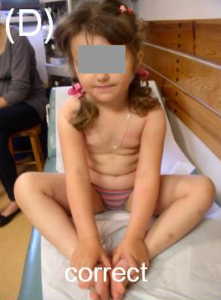
Figure 2: Girl 5 years- In anamnesis and in clinical examination symptoms of Minimal Brain Dysfunction (MBD). On the picture (D) proper sitting position. This position is beneficial for the hips, it enables better development of the joints, it deepens the acetabulum and enables the proper development of the roof. It prevents valgus deformity of knees, enables proper gait. In karate this position is called the butterfly position.
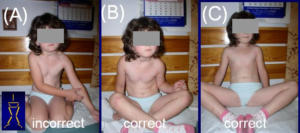
Figure 3: Girl 4 years. In anamnesis and in clinical examination Minimal Brain Dysfunction (MBD). General laxity of joints which leads to pathogical position of both legs while sitting (A). Genua valga may develop. Bigger antetorsion of the femur neck can develop what results in dysplastic hips. Gait with the toes directed inwards in internal rotation of legs. In Figure (B) and (C) proper sitting.
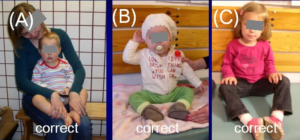
Figure 4: Proper sitting in all children (A) (B) (C). Sitting in the butterfly position – term taken from karate – hips are in full abduction, spine is relaxed. Such position can also correct Antetorsion (AT) of femoral neck, the hips develop properly. It is prevents valgus deformity of knees.
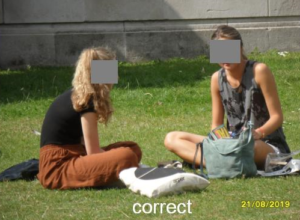
Figure 5: Young persons. Proper sitting. Picture taken on the 21st August 2019 in St. James Park in London, UK duing the Physiotherapy Congress. Such a position is similar or the same as the butterfly position” in karate.
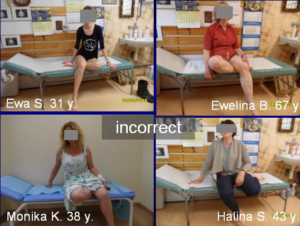
Figure 6: All patients sit incorrectly. In result instability of knee and diminishing of rotation movement of hip appear. Knee pain, problems walking.
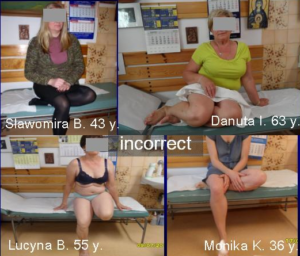
Figure 7: All patients sit incorrectly. In result instability of knee and diminishing of rotation movement of hip appear. Knee pain, problems walking.

Figure 8: All patients sit incorrectly. In result instability of knee and diminishing of rotation movement of hip appear. Knee pain, problems walking.
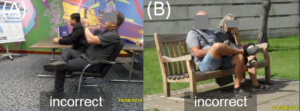
Figure 9: Examples of incorrect sitting. Diminishing abduction and internal rotation of the hips which causes knee instability. All pictures taken in London, August 2019, during the Physiotherapy Congress.
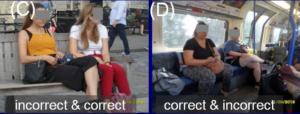
Figure 10: Examples of correct and incorrect sitting. Wrong sitting diminishes abduction and internal rotation of the hips, is the cause of instability of the knees. All pictures taken in London, August 2019, during the Physiotherapy Congress.
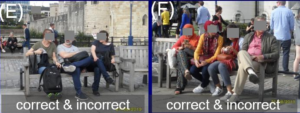
Figure 11: Examples of correct and incorrect sitting. Wrong sitting diminishes abduction and internal rotation of the hips, is the cause of the instability of the knees. All pictures taken in London, August 2019, during the Physiotherapy Congress.

Figure 12: Monika K. Age 38. Right knee pain for two years. Instability because of incorrect sitting (see Fig. 6). On the pictures (A) (B) illustration of exercises for better stabilization of the knee joint. Lifting of the leg 2 cm. Movement of foot-dorsal (A) and plantar (B) flexion 4-5 seconds. Repeated many times, for many days or weeks.

Figure 13: Halina S. Age 43. Left knee pain for four years. Instability because of incorrect sitting (see Fig. 6). On the pictures (A) (B) illustration of exercises for better stabilization of the knee joint. Lifting of leg 2 cm. Movement of foot-dorsal (A) and plantar (B) flexion 4-5 seconds. Repeated many times, many days or many weeks.


